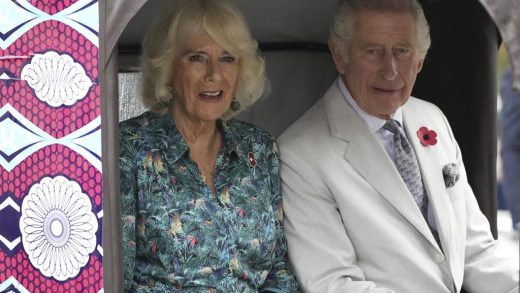
It was less of a news conference and more of a requiem for a once-great party and its reluctant leader.
Just after 3 p.m. on Monday, Progressive Conservative Leader Heather Stefanson walked into an unusually small, alarmingly cold room at the Tory campaign office in the Maples, to the rousing cheers and applause of 20 candidates.
Stefanson beamed as she walked into the tiny room and high-fived as many of those candidates as possible. And then, without even a mention of the long odds her party faces on election day, Manitoba’s first woman premier delivered a fully costed campaign platform.
RUTH BONNEVILLE / WINNIPEG FREE PRESS In the end, Premier Heather Stefanson’s weak attempt to defend the indefensible decision to essentially abandon her candidates in Winnipeg spoke volumes about the Tory campaign.
At first, it was hard to determine what the Tories expected from this event, held at nearly the last possible moment in the campaign news cycle. There was nothing new in the platform document or Stefanson’s speech.
And, it should be noted, the event wasn’t much a draw for either journalists or Tory candidates.
Only the bare minimum of media showed up for the big platform reveal, and the candidate group was noteworthy more for who wasn’t there — no Rochelle Squires, Audrey Gordon, Ron Schuler or Obby Khan — than for who was.
None of that would have mattered if, somehow, Stefanson had mustered a strong performance that might leave voters with a positive final image. That didn’t happen; even when asked some fairly straightforward questions afterward, Stefanson waffled and stammered and refused to provide direct answers.
If this turns out to be the last time that Stefanson appears in public as the leader of a governing party — and all signs currently point to a forceful termination this PC government — it will have been a fitting metaphor for all that was wrong with her campaign and her leadership.
In the brief media scrum following the platform reveal, it was noted that this was the first time in about a week that Stefanson had made herself available to answer questions from reporters. When asked about offloading campaign announcements to other candidates and spending the last weekend of the campaign evading Winnipeg media by travelling through rural ridings, Stefanson kept repeating an awkward line about how her “team of individuals” was more than capable of handling the work of selling the Tory plan.
In the end, Stefanson’s weak attempt to defend the indefensible decision to essentially abandon her candidates in Winnipeg spoke volumes about the Tory campaign.
The PC war room’s decision to abandon the traditional Tory narrative, which would at least have paid some lip service to the notions of “progressive” and “conservative”, remains a mystery — not just because it clearly has not worked, but also because it is clear now it was always destined to alienate as many, if not more, people than it was ever going to attract.
This campaign abandoned big-tent politics and estranged moderate Tories, pandering instead to tiny splinter constituencies: parental-rights messaging tailored to hard-right social conservatives hell-bent on a culture war with the LGBTTQ+ community; and a relentless celebration of Stefanson’s refusal to search for the remains of Indigenous women in the Prairie Green landfill, seemingly intended to buoy the spirits of reconciliation-weary racists.
What, exactly, were the Tories hoping to build with their coalition of the angry?
While the Liberals struggled to escape their own organizational incompetence and the NDP stormed through a tight and disciplined campaign free of self-inflicted wounds, the Tories spent their entire campaign lashing out with angry and cynical hyperbole.
The final example of this corrosive crusade was a curious advertisement that appeared (briefly) online and in a wrapper ad in Monday’s Free Press. The ad stated that upon entering the voting booth, people can vote “how you feel, not how others say you should,” without “fear of being judged.”
This pleading with supporters to ignore all of the toxic content in the PC platform and cling to the party’s now-tarnished brand has set new standards for political hubris. It’s surprising the ad didn’t contain a warning at the bottom: “After checking the box for the Tory candidate in your riding, please refrain from telling anyone how you voted.”
When asked about the ad, Stefanson would only say the PCs wanted to tell Manitobans not to be “bullied” into making a ballot-box decision. Who’s doing the bullying, and for what purpose, was never explained.
One of the harshest criticisms you can level against a political leader is that they do not actually believe the things they are saying — in other words, suggesting a leader would say something they personally do not believe in order to accomplish a political goal.
Throughout this campaign — and certainly on Monday afternoon — there has been a persistent feeling that Stefanson did not appear like a leader who actually believed what she was saying.
Win or lose, two hard truths have become clear:
First, that division and hate are the last refuge of political scoundrels.
And second, that even if Stefanson didn’t actually believe some of what she said, this divisive and cynical campaign is now permanently bolted to her political legacy.
As it should be.

Dan Lett
Columnist
Born and raised in and around Toronto, Dan Lett came to Winnipeg in 1986, less than a year out of journalism school with a lifelong dream to be a newspaper reporter.
Read full biography


